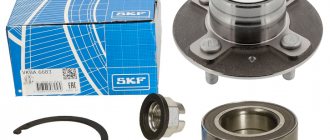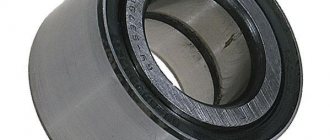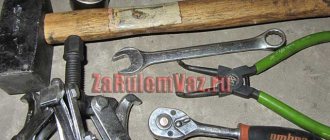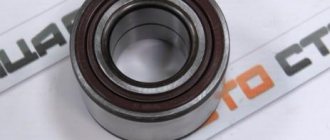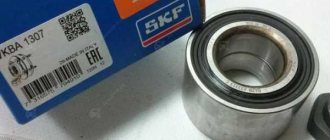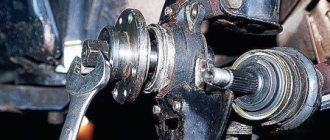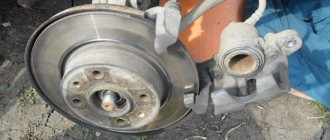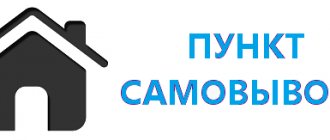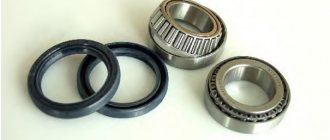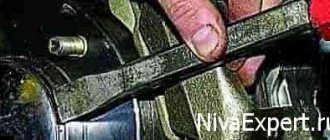Car rear wheel bearings are a type of bearing support that ensures the rotation of the rear wheel of a car and its rigid fixation on the axle. The bearing itself is located in the hub, to which the wheel is in turn attached. Bearings differ in design, size, and technical characteristics.
In this article we will consider the following questions:
- Methods for replacing rear wheel bearings;
- Causes and symptoms of malfunction;
- Types of wheel bearing units, numbers and sizes;
- Tips for use and replacement.
To begin with, we present 2 typical layouts of parts. In the diagram on the left is a non-separable hub assembly with HUB-3 (3rd generation bearing) - on the right is HUB-1 (1st generation).
What are the types of wheel bearing malfunctions?
- Depressurization of the seals on the side of the wheel and the ABS sensor is the main malfunction.
- Fatigue failure of metal, peeling due to prolonged use.
- Rust, which can appear as a result of water getting on the surface of the inner or outer race, as well as the hub or axle.
- The choice of low-quality parts with deviations in geometric dimensions leads to destruction or rotation of the housing in the knuckle hole or slipping of the hub axis, the wheel wobbles, and play increases.
- Inadequate amount of lubricant leads to jamming.
Replacing the hub bearing on the front axle
The general algorithm is the same, with the exception of features in the design of the car:
- The battery device is switched off;
- The bolts on the wheel are loosened;
- Using a lift or shoes with a jack, the front wheel is raised;
- The protective cap at the hub nut is compressed. Then the hose is removed from the drive shaft, more specifically from the threaded cap;
- After the assistant presses the brake, the nut on the hub is unscrewed;
- The wheel is removed;
- The brake caliper is unscrewed from its mounting location so as not to damage the hoses. The part is carefully secured to the body with wire. The hoses must remain free;
- The ABS sensor connector is disconnected;
- The disk is removed after unscrewing the screws;
- The steering tip is disconnected from the rack, then the same is done with the conical tip;
- The stand must be pulled slightly towards you to remove the splined part from the hub;
- Using a puller, you have to remove the hub and the bearing with it;
- The new set is pressed in. A separately made bearing is installed not in the old hub, but in the new one;
Assembly is carried out in reverse order.
Symptoms and diagnostics
The main symptom is excessive noise, which increases while driving. The second important sign is the presence of play in the wheel.
To more accurately determine the malfunction and understand on which side a new part will need to be installed, you must:
- At a speed of 10-15 km/h, sharply turn the steering wheel to the left, after which this extraneous noise will disappear, which means that the noise comes from the left wheel, or more precisely, from its hub bearing.
- If the noise disappears when turning to the right, then you will have to change the bearing on the right wheel.
To carry out 100% diagnostics, follow the instructions:
- Raise the car with a lift or jack.
- If the car has front-wheel drive, then start the engine and pick up speed at 70-80 km/h.
- Next, you should determine by ear which wheel is making the most noise.
- If the wheel is not driving, then you can spin it by hand.
- After stopping the wheel, you need to grab the upper part with one hand and the lower part with the other.
- Try to swing the wheel in a vertical plane.
- Even if there is slight play, the bearing will have to be replaced.
- Similarly, shake the wheel in a horizontal plane.
Note:
It happens that play appears due to malfunctions of the suspension elements, or due to improper tightening of the hub nut. To make sure that the problem is not in the suspension, you need to press the brake pedal and check the vertical play. If the play does not disappear, then you need to look for the cause in the suspension. You should also check the tightening torque of the lock nut; instructions are in the article “How to tighten the hub nut and with what torque.”
How to determine the need for replacement?
Strong noise, humming of the rear hub bearing of VAZ 2109, 2110, “howling” from the rear, which intensifies when turning, clearly indicates the need to check the condition of the rear hubs. The verification methods are quite simple:
- Be sure to stop the wheel diagonally opposite from the jacking side, and then jack up each rear wheel one by one. (Why each? The fact is that very often there are errors in determining the side of the hum, and even more often there is a need to replace both bearings).
- When the wheel is raised, you need to try to spin it as much as possible. If at the same time you hear extraneous sounds similar to a hum, you don’t have to check further - replacement is necessary.
- If in doubt, you can also check the lateral play of the bearing by grasping the edges of the wheel and rocking it towards you - away from you. If you feel the wheel moving on the axle, the bearing needs to be replaced.
Automotive stores can offer you both a separate bearing and a hub assembly. We see no point in purchasing an assembled unit (except for the cases described below), where replacing the bearing is not at all a difficult matter.
Causes of wheel bearing failure
Friction is the main enemy of balls or rollers. Over time, the lubricant loses its quality and abrasion begins on the spherical surface of the elements enclosed inside the cages. A sign is excessive heating, an increasing hum while driving, a metallic grinding sound.
Failure of one of the assembly elements: the axle or hub will certainly affect the operation of the bearing: the force of impacts on the cages will increase, and excessive axial and radial loads will appear.
Other reasons:
- extreme riding;
- poor road and climatic conditions: dirt, dust, potholes;
- improper installation, adjustment, use of impact methods when assembling the unit.
Recommendations for further use
Careful driving can extend the life of the wheel bearing. Avoid driving over potholes and other obstacles at high speed. It is also not recommended to sharply increase speed unless necessary and install wheel rims with a diameter different from the factory version. The optimal tire sizes are written on the bottom of the driver's door.
When the car is operated on bad roads, it is necessary to diagnose the chassis more often at service stations. Specialists will identify and fix the problem, which will prevent a possible accident.
Replacing the rear wheel bearing
There are also several repair methods:
- With the removal of the rack;
- Without removing the stand;
- Using a puller/press;
- No puller/press.
The first steps in the instructions are similar for almost all passenger cars:
- We choose a flat area.
- Loosen the wheel nuts.
- We jack up the rear wheel.
- We place a support under the rear of the car, and place a wheel chock under the front wheel.
- We lower the car onto a support using a jack.
REPLACEMENT INSTRUCTIONS BY VEHICLE BRAND:
On our website you can see detailed instructions with photos and videos for all types of designs and techniques for the following car models:
- Chevrolet:
- Lanos
- Aveo
- Lacetti
- Fusion
- Nexia
- Logan
- 206
- Gazelle
- Accent
- Sportage
Note:
If your car is not on the list, choose by brand, in 90% of cases the instructions will be suitable for you!
Step-by-step instructions: replacing the rear axle bearing
At the beginning of the article, diagrams of the main components of the rear axle shaft of the KIA Sportage are shown. This car in 2WD and 4WD versions has a different design of the rear hub assembly, so we took this car as an example of repair.
Differences in the hub assembly: On the left, the HUB-3 is a non-separable unit. On the right, HUB-1 is a dismountable unit: HUB-1 is sequentially pressed into the hole of the fist 1, then the hub axle 2.
- Removing the wheel.
- Unscrew the 2 diametrically located screws securing the brake disc.
- Unscrew the 2 caliper mounting bolts.
- We dismantle the caliper and check whether the pads need to be changed.
- Removing the brake drum (disc).
- Unscrew the central nut and remove the pressure washer.
- Trying to knock out the axle shaft with a hammer is sometimes unsuccessful.
- We squeeze out the axle shaft with a puller, unscrew the fastenings of the levers and supports, and free the fist.
Photo report:
Replacing the rear wheel bearing using a special puller without removing the assembly
- We install a device called an impact hammer on the hub studs.
- It will take a few hard hits and the hub will come off, but often there will be clips left on it and inside the knuckle.
- We remove the axle shaft from the hole in the fist.
- We take out the retaining ring from the fist socket.
- We charge a screw puller - a set of a long rod (bolt) and a set of washers and round plates (pancakes) for the diameters of the outer and inner races, wide rings.
- We rest the round plate against the hole in the fist, and pass the rod (long bolt) into the hole in the plate. On the other end of the rod we put a plate along the diameter of the outer race and press it with a nut. We begin to tighten the bolt and place the key on the back side.
- Use a powerful wrench or a hand tool with an extension as a wrench. The bearing housing will move forward so that it comes out further, add a wide ring.
It is important to know:
Pay attention to the selection of the puller plates: they must match the diameters of the cages.
Photo report:
Instructions for replacing the wheel bearing with removing the unit
Points up to 7 are the same as in the step-by-step instructions.
- We unscrew the bolt securing the ABS sensor, pull it out of the socket, and put it aside.
- We unscrew the bolts of the rods and levers attached to the knuckle axles.
- We disassemble the handbrake mechanisms: pay attention to the guide pins of the springs; if you are doing this for the first time, take a photograph of the position of the parts.
- We release the handbrake cable, take out the fixing bracket on the reverse side, and pull out the cable.
- Unscrew the 2 bolts securing the shock absorber strut from the knuckle axle.
- Remove the assembly completely.
Photo report
Replacing the rear wheel bearing on a pressing machine
- We take out the retaining ring.
- After dismantling the hub, install a clamp or puller.
- First we press out the hub, then the bearing.
Assembly of the unit
- After purchasing a new part, press it into the hub
- See if the retaining ring should be replaced with a new one.
- Press the hub into the assembly.
- Next, we carry out the installation in reverse order.
Photo report
Replacing the rear wheel hub flange assembly
A non-separable unit, when the bearing is combined with the hub, is easier to replace: disconnect the rear axle flange, just unscrew a few bolts, but this depends on the design of the flange.
- We remove the caliper and brake disc - operations as in the previous instructions.
- If the disk is clamped, turn the adjusting wheel with a screwdriver through the special hole. Depending on which side you remove the disc from, rotate the wheel teeth down or up.
- The HUB-3 flange mounting bolts can be accessed after removing the shock absorber. First place a stand under the rack arm.
- Unscrew the 4 flange mounting bolts, disconnect the ABS connector, and remove the wheel bearing.
- Check the numbers of the old and new rear wheel bearings.
- Clean the flange seat. Installation in reverse order.
Photo report
Video instructions
Replacing the rear wheel bearing on a Kia Sportage
Kia Sportage - rear wheel bearing replacement
Diagnostics of the rear bearing, signs of failure
Before you begin repairs, be sure that it is the wheel bearing assembly that has failed; the signs of this are as follows:
- Chassis play, felt by hand;
- Noise and hum of the rear wheel increases as speed increases;
- Leakage of lubricant from oil seals;
- Grinding and squeaking occurs when the raceways are destroyed, the cage is deformed, and the rollers fall out.
The front wheel bearing has similar signs of failure.
Procedure for checking the Daewoo Nexia wheel bearing:
- Raise the rear of the car with a jack;
- Rotate the chassis and listen to the sound of rotation;
- Check the play by moving the wheel axially.
- The video shows the process of diagnosing and checking rear wheel bearings.
Rear bearing diagnostics
Types of designs of rear wheel hub units
- HUB-1 has two rows of angular contact ball or roller assemblies enclosed in cage cells.
The factory seal reliably seals the internal parts from water and abrasive particles. The lubricant prevents friction forces. Operation under normal conditions reaches a mileage of 100,000 km.
- HUB-3 is a prefabricated structure with a flange.
The flanges are attached: one to the fist - the second is connected to the brake and wheel disc. If it fails, after approximately 150,000 km of run under normal operating conditions, the whole thing is replaced. HUB-3 with splines is designed for drive wheels.
Also, built-in ABS/speed sensors are added to the design of these bearings.
- Two single row bearings are pressed inside the hub.
They are pressed into the hub on both sides, the assembly is pressed onto the knuckle axle and secured with a hub nut. The design is typical for non-driving rear and front wheels of some car models. They are equipped with oil seals and, in some cases, an adjusting spacer ring.?
How to tighten a hub nut without a torque wrench
Many car enthusiasts, when repairing their car, consider it not advisable to purchase torque wrenches or other specialized devices (pullers, etc.). There is a good way to tighten the fastener to the required torque without using a torque gauge. The following devices will be required: 1. Ratchet with a head for a lock nut; 2. Pipe for extending the ratchet to create the required “shoulder”; 3. Roulette; 4. Marker; 5. A weight that can be hung on the “shoulder” (for example, a 32 kg weight).
Tips for maintenance and operation of bearings
- How to lubricate a wheel bearing.
- Keep dust away from grease and bearings. Lubrication of external surfaces prevents corrosion. For external lubrication, perform the following operations:
- First, you need to cleanly rinse the seat of the clip with kerosene, wipe it dry, then lubricate the seating surface with a thin layer of lubricant. Put on a clean rubber glove, apply lubricant to your palm and rub it into the bearing, then insert the part inside and additionally wipe the surface with a rag moistened with lubricant.
- You can use any anti-corrosion lubricant; specialized lubricants for bearing units are sold on the market. When applying, observe the amount of lubricant - there should be no leaks from the unit.
- Lubrication of the bearing inside is possible if it is open or has rubber seals. Add lubricant inside, but here you also need to follow an important rule - there should be no excess lubricant (turn the races repeatedly, excess lubricant will come out, it should be removed).
Recommended lubricant is presented in the table:
| Lubricant brands | Manufacturers | Thickener | Base oil |
| RareMax AF-1 | Kyodo Yushi Co., Ltd. | Urea | Mineral oil |
| 6459 Grease N | Showa Shell Sekiyu, KK | Urea | Mineral oil |
| Pyronoc Universal N-6C | Nisseki Mitsubishi Oil Corporation | Urea | Mineral oil |
| HB-1 | Kyodo Yushi Co., Ltd. | Urea | Mineral oil |
| Ronex MP | Exxon/Mobil | Lithium | Mineral oil |
- How to extend service life.
Tighten the axle nut to the recommended torque. Excessive tension will cause excess friction, the lubricant will heat up, dry out, and the rubbing parts will become deformed. Insufficient fastening torque will cause more play than is permissible, which will lead to premature wear. Use original spare parts (nut, cotter pin, retaining ring, etc.) to repair bearings.
Calculate service life "Wheel Bearing Life Calculator"
Read the article “Tightening torque of wheel bearings”
- Which wheel bearing to choose based on manufacturer, and what to look for when purchasing.
The original number is indicated on the case; the manufacturer recommends installing it. If it is not possible to get the original, there are replacement brands. The main thing is that the dimensions and technical characteristics match. On the packaging, look at the inscriptions, barcode, stamped number on the case, and the package contents.
Read the article “Rating of the best wheel bearing manufacturers”
- Wheel bearing kit - what it includes.
The repair kit includes consumable parts: wheel nuts 1 or 2 pcs., wheel bolts - set, lock ring 2 pcs. cotter pin Possible oil seals, outer races and even lubricant.
- What to use a press or puller.
For high-quality work, use a press, remove the assembly, take it to a service station, and for a small fee they will replace the assembly parts in 1-1.5 hours. The puller is used when replacing independently, purchased or rented. An assistant's hand will be useful for holding the key.
Important point:
Do not put pressure on the inner race of the bearing, as this may damage the elements of the bearing assembly.
- ABS bearings.
The presence of an impulse ring can be easily checked by placing a metal object on one side of the seals. The magnetized side is placed inside the hole of the fist to the connector of the reading sensor.
How to tighten the hub nut to the correct torque
To tighten threaded connections, where it is recommended to maintain a certain torque, use special torque wrenches . Inside the tool there is a dynamometer with a scale or a special device with a limiter, which is activated when the required tightening force is reached. Keys also come with value intervals, for example 5-25 (minimum 5 N•m, maximum 25 N•m). The threaded connection is tightened until the arrow shows the required value or the limiter operates. There are also expensive and exact analogues - with an electronic display, but for the operation and repair of passenger cars a mechanical version is suitable.
The photo shows the main types of such keys.
- With preset torque, not adjustable.
- With preset torque value, adjustable.
- With tightening force indicator.
- With digital display of applied torque.
Watch the video on how to use a torque tool:
